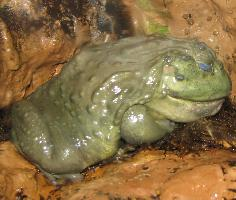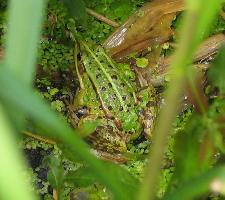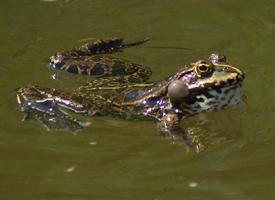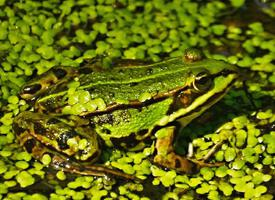
Známé také jako
- Skokan hrabavý
Váhy a míry
| Délka | od 8 do 25 cm |
|---|
Stav ohrožení
| Neohrožen |
Popis zvířete
The African bullfrog, scientifically known as Pyxicephalus adspersus, is a robust and imposing amphibian native to parts of Sub-Saharan Africa. It is one of the largest frog species found on the African continent and is known for its distinctive appearance and behavior.An adult African bullfrog is a sight to behold, with males reaching sizes of up to 25 centimeters (9.8 inches) in length and weighing as much as 2 kilograms (4.4 pounds), though females are generally smaller. This species is characterized by its stout body, which is adapted to a life spent both in water and on land. The skin is thick and often textured with warty projections, and it comes in a variety of colors, typically ranging from olive green to brown, with occasional yellow or grayish hues. The underbelly is often a lighter color, providing a contrast to the darker dorsal side.
One of the most striking features of the African bullfrog is its massive head, which seems almost oversized compared to the rest of its body. The head houses a wide mouth equipped with powerful jaws and sharp teeth, which are quite unusual for a frog. These teeth are not used for chewing but are instead an adaptation that helps the bullfrog grab and hold onto its prey.
The eyes of the African bullfrog are prominent and bulging, providing it with a wide field of vision to spot potential prey and predators. Just behind the eyes, one can find the tympanum, or eardrum, which is a critical component of the frog's auditory system, allowing it to hear both airborne and vibrational sounds.
Males are known for their deep, resonant calls, which they use to attract females during the breeding season. The call of the African bullfrog is often likened to the roar of a bull, hence its common name. During the breeding season, males become territorial and can be aggressive towards other males, wrestling and biting in competition for mating rights.
African bullfrogs are carnivorous and have a voracious appetite. Their diet includes a variety of invertebrates such as insects, spiders, and snails, as well as small vertebrates like rodents, reptiles, and even other amphibians. They are sit-and-wait predators, remaining motionless until an unsuspecting prey item comes within range, at which point they strike with remarkable speed.
The African bullfrog is also known for its remarkable parental care, which is quite unusual among amphibians. Males guard the breeding sites, which are typically shallow pools of water, and ensure the survival of the tadpoles by maintaining the water's depth and quality. They have been known to dig channels to redirect water during dry spells, and they aggressively defend the tadpoles from potential predators.
Adapted to a life in a challenging environment, the African bullfrog has developed the ability to survive long periods of drought by burrowing into the ground and entering a state of estivation, a form of dormancy. During estivation, its metabolism slows down significantly, and it can remain in this state for months, or even up to a year, until the rains return and it can emerge to feed and breed once more.
The African bullfrog's conservation status is currently of least concern, as the species is widely distributed and relatively common within its range. However, habitat destruction, pollution, and the pet trade pose threats to its populations. Conservation efforts are essential to ensure that this remarkable species continues to thrive in its natural habitat.
Podobná zvířata
Nové fotografie zvířat
Top 10 zvířat
- Chinese water dragon (Physignathus cocincinus)
- Galápagos tortoise (Geochelone nigra complex)
- Dolphin gull (Leucophaeus scoresbii)
- Japanese macaque (Macaca fuscata)
- Colombian red howler (Alouatta seniculus)
- Sea urchins (Echinoidea)
- Moustached guenon (Cercopithecus cephus)
- Diana monkey (Cercopithecus diana)
- Common reed warbler (Acrocephalus scirpaceus)
- Common house mosquito (Culex pipiens)


